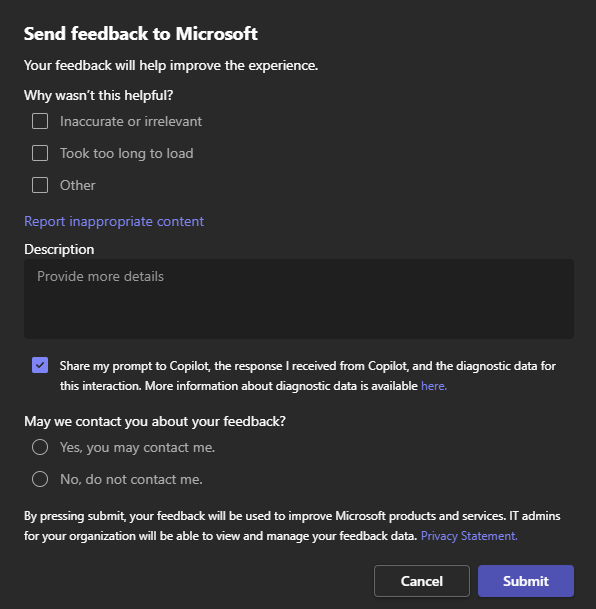Review best practices for using Copilot for Microsoft 365
To fully harness the potential of Copilot for Microsoft 365, it's essential to grasp both its capabilities and the guidelines for its optimal and safe usage. The following best practices help you extract maximum value from this AI-powered productivity assistant.
Provide a clear and concise prompt
Providing a clear and concise prompt is fundamental to harnessing the true potential of Copilot for Microsoft 365. The more specific and detailed your instruction, the better Copilot can align its response to your intended outcome. As illustrated in the following examples, moving from a generic to a comprehensive prompt can drastically improve the quality and relevance of Copilot's output, ensuring you receive content that perfectly matches your requirements. For example:
- Good prompt. "Draft an email about our new Contoso 3D printers."
- Better prompt. "Draft an email introducing our new Contoso 3D printers to our customers."
- Best prompt. "Draft an email detailing our new Contoso 3D printers features, launching next week. Include a link to the product page."
The next unit in this training module examines specific prompting best practices.
Trust but verify
One of the goals of Copilot for Microsoft 365 is to provide insightful and accurate recommendations. However, like any tool, it's essential to review and verify its outputs. Doing so ensures the generated content aligns with your specific intentions and meets the professional standards of your organization. Remember, an extra layer of human oversight can make a significant difference in quality assurance.
Provide regular feedback
Copilot for Microsoft 365 continues to improve over time as a result of user feedback. If Copilot doesn't provide the expected output, it's critical that you provide Microsoft with feedback. By actively sharing your observations and suggestions, you play a crucial role in enhancing Copilot's performance and precision. This iterative feedback loop ensures Copilot stays aligned with your needs and continually identifies areas for growth and refinement.

Avoid over-reliance
The capabilities of Copilot for Microsoft 365 are vast, but it shouldn't replace human judgment entirely. While it provides a foundation, critical thinking and personal expertise are irreplaceable. Utilizing Copilot as a supplementary tool, rather than the sole source, helps balance automation with intuition, ensuring optimal outcomes every time.
Unlock your creativity
Copilot for Microsoft 365 offers more than just routine outputs; it can be a springboard for creative ideas. Diverse prompts can yield a various results, unveiling fresh viewpoints and ideas. By pushing Copilots boundaries and experimenting, you can uncover new insights and inspire innovation in your tasks.
Prioritize privacy and security
Privacy and security are paramount in today's digital age. While Copilot for Microsoft 365 is designed with rigorous security protocols, users should always practice caution. Be mindful of the information you provide, especially when it pertains to sensitive or proprietary data. This proactive approach guarantees both efficiency and data integrity.
Stay updated
Copilot for Microsoft 365 is a continuously evolving tool. It's crucial to stay in tune with its regular updates, feature enhancements, and refinements. As Copilot grows, adapt your working habits to embrace its expanding capabilities. Always remain open to feedback, both from Copilot and your peers, ensuring you harness its full potential to streamline your workflow.
Note
The best practices provided in this unit serve as general guidelines for utilizing Copilot for Microsoft 365 effectively and securely. This list isn't exhaustive. Depending on the specific nature of your tasks, the app you're using Copilot with, or unique circumstances of your usage, there may be other best practices or considerations to be aware of. Always prioritize the unique requirements and standards of your specific context when using any tool or technology.